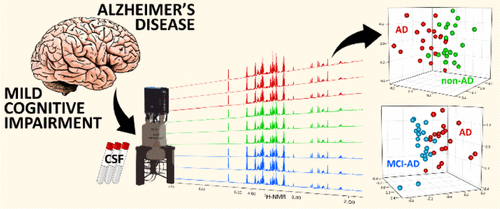当前位置:
X-MOL 学术
›
J. Proteome Res.
›
论文详情
Our official English website, www.x-mol.net, welcomes your
feedback! (Note: you will need to create a separate account there.)
Fingerprinting Alzheimer's Disease by 1H Nuclear Magnetic Resonance Spectroscopy of Cerebrospinal Fluid.
Journal of Proteome Research ( IF 3.8 ) Pub Date : 2020-03-02 , DOI: 10.1021/acs.jproteome.9b00850 Alessia Vignoli 1, 2 , Silvia Paciotti 3, 4 , Leonardo Tenori 1, 2 , Paolo Eusebi 3 , Leonardo Biscetti 3 , Davide Chiasserini 4 , Philip Scheltens 5 , Paola Turano 1, 6 , Charlotte Teunissen 7 , Claudio Luchinat 1, 2, 6 , Lucilla Parnetti 3
Journal of Proteome Research ( IF 3.8 ) Pub Date : 2020-03-02 , DOI: 10.1021/acs.jproteome.9b00850 Alessia Vignoli 1, 2 , Silvia Paciotti 3, 4 , Leonardo Tenori 1, 2 , Paolo Eusebi 3 , Leonardo Biscetti 3 , Davide Chiasserini 4 , Philip Scheltens 5 , Paola Turano 1, 6 , Charlotte Teunissen 7 , Claudio Luchinat 1, 2, 6 , Lucilla Parnetti 3
Affiliation

|
In this study we sought for a cerebrospinal fluid (CSF) metabolomic fingerprint in Alzheimer's Disease (AD) patients characterized, according to clinical picture and CSF AD core biomarkers (Aβ42, p-tau, and t-tau), both at pre-dementia (mild cognitive impairment due to AD, MCI-AD) and dementia stage (ADdem), and in a group of patients with a normal CSF biomarker profile (non-AD), using untargeted 1H-nuclear magnetic resonance (NMR) spectroscopy-based metabolomics. This is a retrospective study based on two independent cohorts: a Dutch cohort, which comprises 20 ADdem, 20 MCI-AD and 20 non-AD patients, and an Italian cohort, constituted by 14 ADdem, and 12 non-AD patients. 1H-NMR CSF spectra were analyzed using OPLS-DA. Metabolomic fingerprinting in the Dutch cohort provides a significant discrimination (86.1% accuracy) between ADdem and non-AD. MCI-AD patients show a good discrimination with respect to ADdem (70.0% accuracy), but only slight differences when compared with non-AD (59.6% accuracy). Acetate, valine, and 3-hydroxyisovalerate result to be altered in ADdem patients. Valine correlates with cognitive decline at follow-up (R = 0.53, P = 0.0011). The discrimination between ADdem and non-AD was confirmed in the Italian cohort. The CSF metabolomic fingerprinting shows a signature characteristic of ADdem patients with respect to MCI-AD and non-AD patients.
中文翻译:

通过1H核磁共振波谱对脑脊液进行指纹识别阿尔茨海默氏病。
在这项研究中,我们寻找阿尔茨海默氏病(AD)患者的脑脊液(CSF)代谢组学指纹,根据临床图片和CSF AD核心生物标志物(Aβ42,p-tau和t-tau)的特征,均在痴呆前(由于AD,MCI-AD引起的轻度认知障碍)和痴呆阶段(ADdem),并且在一组具有正常CSF生物标记物特征(非AD)的患者中,使用基于非靶向1H核磁共振(NMR)光谱代谢组学。这是一项基于两个独立队列的回顾性研究:一个荷兰队列,由20名ADdem,20名MCI-AD和20名非AD患者组成;以及一个意大利队列,由14名ADdem和12名非AD患者组成。使用OPLS-DA分析1 H-NMR CSF光谱。荷兰人群中的代谢组学指纹图谱可对ADdem和非AD进行显着区分(准确度达86.1%)。MCI-AD患者显示出对ADdem的良好区分(准确度为70.0%),但与非AD相比(准确度为59.6%)只有很小的差异。乙酸,缬氨酸和3-羟基异戊酸酯的结果在ADdem患者中得到改变。缬氨酸与随访时的认知能力下降相关(R = 0.53,P = 0.0011)。意大利队列证实了ADdem与非AD之间的区别。CSF代谢组学指纹图谱显示ADdem患者相对于MCI-AD和非AD患者的特征。意大利队列证实了ADdem与非AD之间的区别。CSF代谢组学指纹图谱显示ADdem患者相对于MCI-AD和非AD患者的特征。意大利队列证实了ADdem与非AD之间的区别。CSF代谢组学指纹图谱显示ADdem患者相对于MCI-AD和非AD患者的特征。
更新日期:2020-04-24
中文翻译:

通过1H核磁共振波谱对脑脊液进行指纹识别阿尔茨海默氏病。
在这项研究中,我们寻找阿尔茨海默氏病(AD)患者的脑脊液(CSF)代谢组学指纹,根据临床图片和CSF AD核心生物标志物(Aβ42,p-tau和t-tau)的特征,均在痴呆前(由于AD,MCI-AD引起的轻度认知障碍)和痴呆阶段(ADdem),并且在一组具有正常CSF生物标记物特征(非AD)的患者中,使用基于非靶向1H核磁共振(NMR)光谱代谢组学。这是一项基于两个独立队列的回顾性研究:一个荷兰队列,由20名ADdem,20名MCI-AD和20名非AD患者组成;以及一个意大利队列,由14名ADdem和12名非AD患者组成。使用OPLS-DA分析1 H-NMR CSF光谱。荷兰人群中的代谢组学指纹图谱可对ADdem和非AD进行显着区分(准确度达86.1%)。MCI-AD患者显示出对ADdem的良好区分(准确度为70.0%),但与非AD相比(准确度为59.6%)只有很小的差异。乙酸,缬氨酸和3-羟基异戊酸酯的结果在ADdem患者中得到改变。缬氨酸与随访时的认知能力下降相关(R = 0.53,P = 0.0011)。意大利队列证实了ADdem与非AD之间的区别。CSF代谢组学指纹图谱显示ADdem患者相对于MCI-AD和非AD患者的特征。意大利队列证实了ADdem与非AD之间的区别。CSF代谢组学指纹图谱显示ADdem患者相对于MCI-AD和非AD患者的特征。意大利队列证实了ADdem与非AD之间的区别。CSF代谢组学指纹图谱显示ADdem患者相对于MCI-AD和非AD患者的特征。











































 京公网安备 11010802027423号
京公网安备 11010802027423号